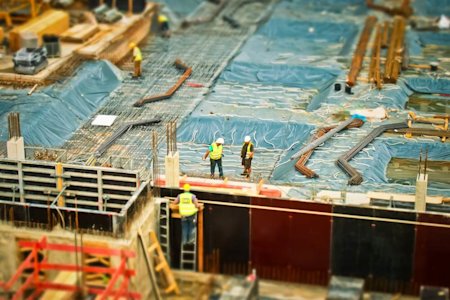Augmented reality is transforming various industries by overlaying digital information onto the real world, enhancing the user's perception and interaction with their environment.
In the construction industry, augmented reality is becoming a pivotal tool, offering innovative solutions to complex challenges. From project planning and design to on-site inspections and remote support, augmented reality is reshaping how construction projects are executed.
This blog explores the significance of augmented reality in construction and its applications.
What is Augmented Reality for the Construction Industry?
Augmented reality (AR) is a technology that enhances the real world by overlaying digital information, such as images, videos, and sounds, onto the physical environment. Unlike virtual reality (VR), which creates a completely immersive virtual experience, AR integrates digital elements into the real world, providing an interactive and enriched experience.
Using devices like smartphones, tablets, or AR glasses, users can view and interact with digital content superimposed on their real-world surroundings. This integration allows for a more engaging and practical application in various fields, including gaming, education, healthcare, and, notably, construction.
In the construction industry, AR can be used for a range of applications, from visualizing building designs and conducting virtual walkthroughs to assisting with remote support. By providing real-time data and visualizations, AR helps construction professionals make more informed decisions, improve accuracy, and enhance overall project efficiency.
What is the Difference Between AR and VR?
AR overlays digital elements onto the real world, enhancing the user's environment through devices like smartphones or AR glasses. VR, on the other hand, creates an entirely immersive virtual environment, isolating the user from the physical world. While AR allows for interaction with both digital and real-world elements, VR offers a completely simulated experience, often requiring specialized headsets. AR enhances reality without replacing it, whereas VR replaces reality with a virtual one.
Learn more about the difference between AR and VR.
Key Applications of Augmented Reality in Construction
AR offers numerous applications in the construction industry, transforming traditional practices and enhancing efficiency. Here are some key applications:
Design Visualization: AR allows stakeholders to visualize 3D models of buildings on-site, providing a realistic view of the final structure. This aids in better design understanding and decision-making.
On-Site Project Management: With AR, project managers can overlay digital information onto the physical site, identifying potential issues and verifying that construction aligns with plans.
Training and Safety: AR provides immersive training experiences for workers, simulating real-world scenarios to improve skills and safety awareness.
Remote Assistance: Technicians can use AR to provide remote guidance, overlaying instructions on the worker’s view, reducing downtime and travel costs.
Maintenance and Repairs: AR enables technicians to visualize hidden elements like wiring and plumbing, streamlining maintenance and repair tasks.
The impact of these applications is profound, leading to increased accuracy, reduced errors, enhanced collaboration, and overall improved project outcomes. AR in construction not only improves efficiency but also facilitates innovation, making it an indispensable tool for the modern construction industry.
Benefits of Augmented Reality in Construction
AR is transforming the construction industry by improving efficiency, accuracy, and collaboration. Here are some of the key benefits:
Improved Accuracy and Fewer Errors – AR allows teams to compare digital plans with on-site progress, reducing mistakes and costly rework.
Faster Decision-Making – Real-time AR collaboration enables remote teams to assess issues and make informed decisions without site visits.
Increased Worker Safety – AR-based training and safety simulations help workers identify hazards and follow safety protocols more effectively.
Streamlined Maintenance and Repairs – AR-assisted diagnostics allow technicians to visualize hidden components, making maintenance tasks faster and more precise.
By integrating AR into construction workflows, businesses can enhance productivity, reduce costs, and improve overall project outcomes.
Challenges in Implementing AR in Construction
Implementing AR in the construction industry comes with several challenges:
New Technology Adoption: The integration of AR requires a shift from traditional methods, which can be met with resistance from stakeholders unfamiliar with the technology.
Learning Curve: Workers and managers must be trained to use AR tools effectively, which can be time-consuming and require additional resources.
Cost: The initial investment in AR hardware and software can be significant, potentially deterring companies from adopting the technology.
Robust Software Solutions: Successful implementation demands reliable and sophisticated software that can handle complex data and operations specific to construction projects.
Integration with Existing Systems: Ensuring that AR technology seamlessly integrates with current construction processes and systems can be challenging and require custom solutions.
Despite these challenges, the benefits of AR in improving efficiency, accuracy, and collaboration make it a worthwhile investment for forward-thinking construction companies.
Growing Importance of Remote Support in Construction
Remote support is becoming increasingly vital in the construction industry, driven by the need for efficiency, cost reduction, and enhanced collaboration. Here are some key use cases:
Technical Assistance: Remote experts can guide on-site workers through complex tasks, reducing the need for physical presence and minimizing downtime.
Troubleshooting and Maintenance: Technicians can diagnose and resolve equipment issues remotely, ensuring quick fixes and preventing project delays.
Training and Skill Development: AR-based remote support offers immersive training sessions, helping workers acquire new skills without the need for on-site trainers.
Collaboration and Communication: AR tools facilitate real-time collaboration between off-site experts and on-site teams, improving decision-making and project coordination.
The adoption of remote support solutions in construction enhances productivity, reduces travel costs, and ensures that expertise is available whenever and wherever it's needed.
Augmenting Remote Support with Splashtop AR
Splashtop AR provides an effective solution for the construction industry by enhancing remote support capabilities through augmented reality. Here’s how:
Interactive Annotations: Technicians can use AR to draw and place markers directly onto the live video feed, guiding on-site workers with precise instructions. This feature is invaluable for troubleshooting and providing step-by-step guidance.
Camera Sharing: Field workers can share their camera feed in real-time with remote experts, allowing for instant visual assessment and assistance. This capability helps in quickly diagnosing issues and providing timely solutions.
VoIP Communication: Integrated voice communication ensures that on-site workers and remote experts can discuss and resolve issues without the need for separate communication tools. This seamless interaction speeds up problem-solving and reduces miscommunication.
Remote Flashlight Control: Remote experts can control the flashlight on the on-site worker’s device, ensuring better visibility in low-light conditions. This feature is particularly useful for inspecting areas that are not well-lit.
Session Recording: Sessions can be recorded for training purposes, quality assurance, and documentation. This feature helps in maintaining records of the support provided and can be used to train new employees.
Splashtop AR enables construction companies to overcome geographical barriers, reduce the need for on-site visits, and improve the efficiency of remote support. By integrating AR into their support workflows, construction firms can ensure quicker resolution of issues, better training for their staff, and overall enhanced productivity.
Get Started with Splashtop AR
Splashtop AR is revolutionizing remote support in the construction industry by integrating advanced augmented reality features. To experience the benefits of enhanced remote assistance, streamlined communication, and efficient problem-solving, consider implementing Splashtop AR in your projects.
Whether you need to provide detailed instructions, perform remote inspections, or facilitate on-site training, Splashtop AR offers the tools you need to succeed. Embrace the future of construction support by learning more about how Splashtop AR can transform your operations.





